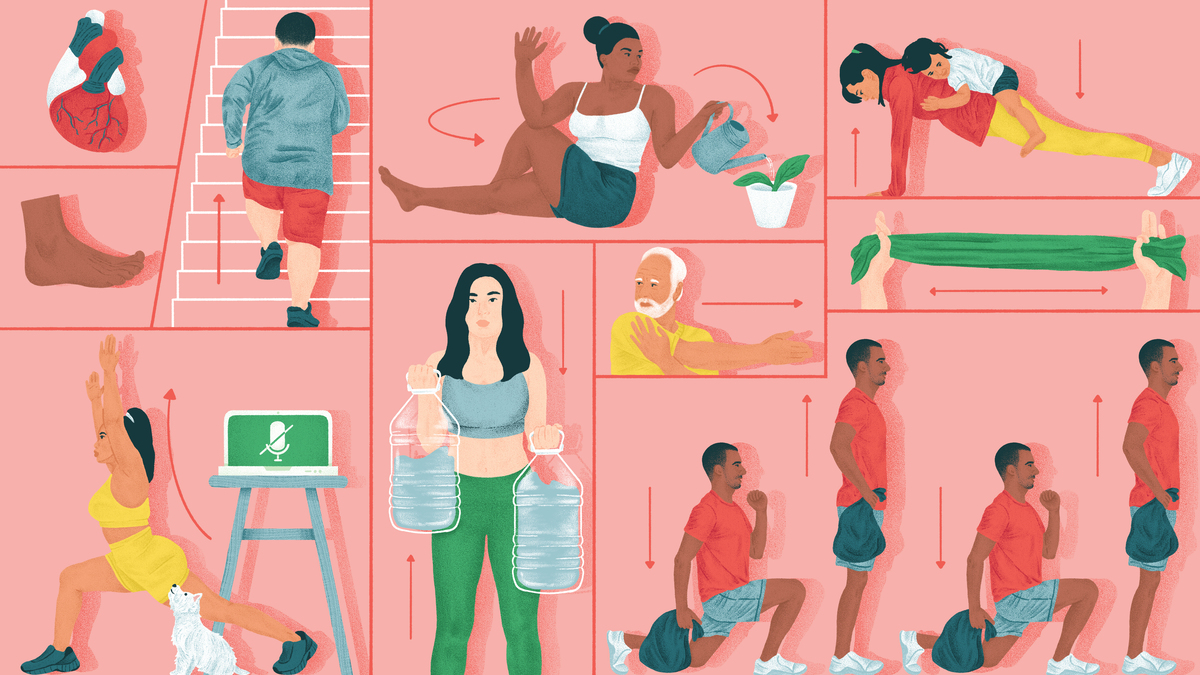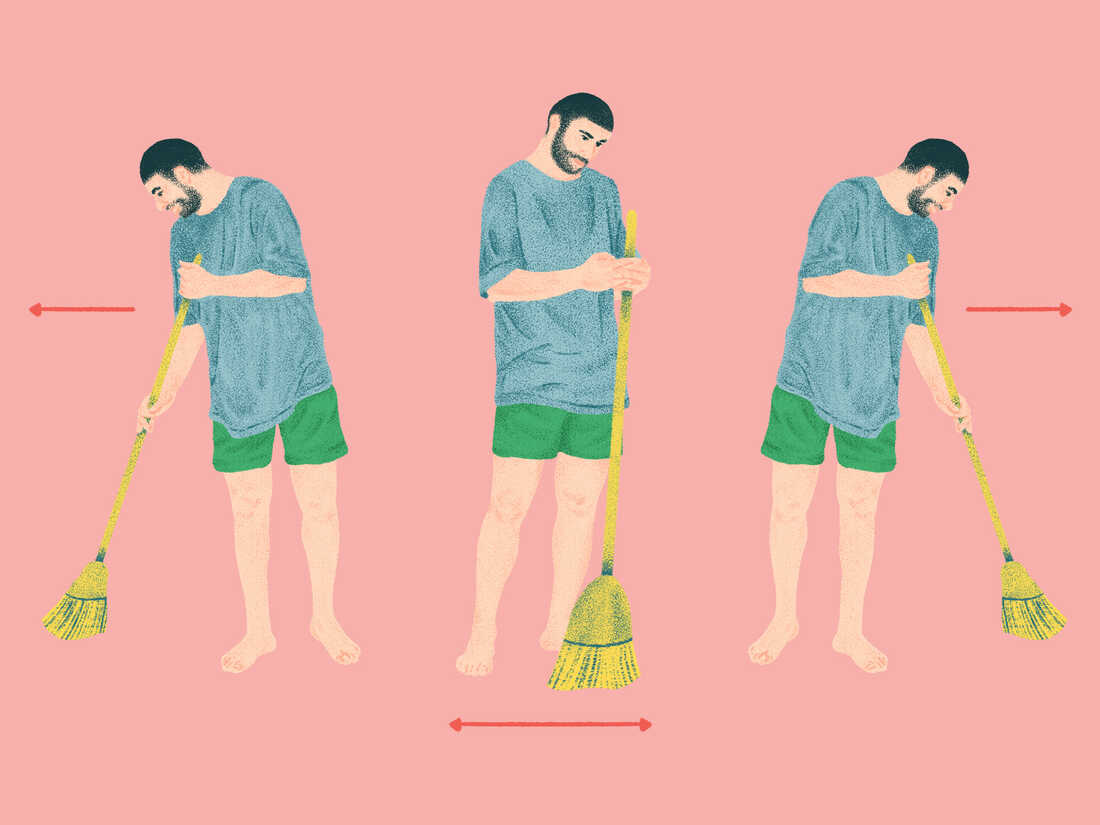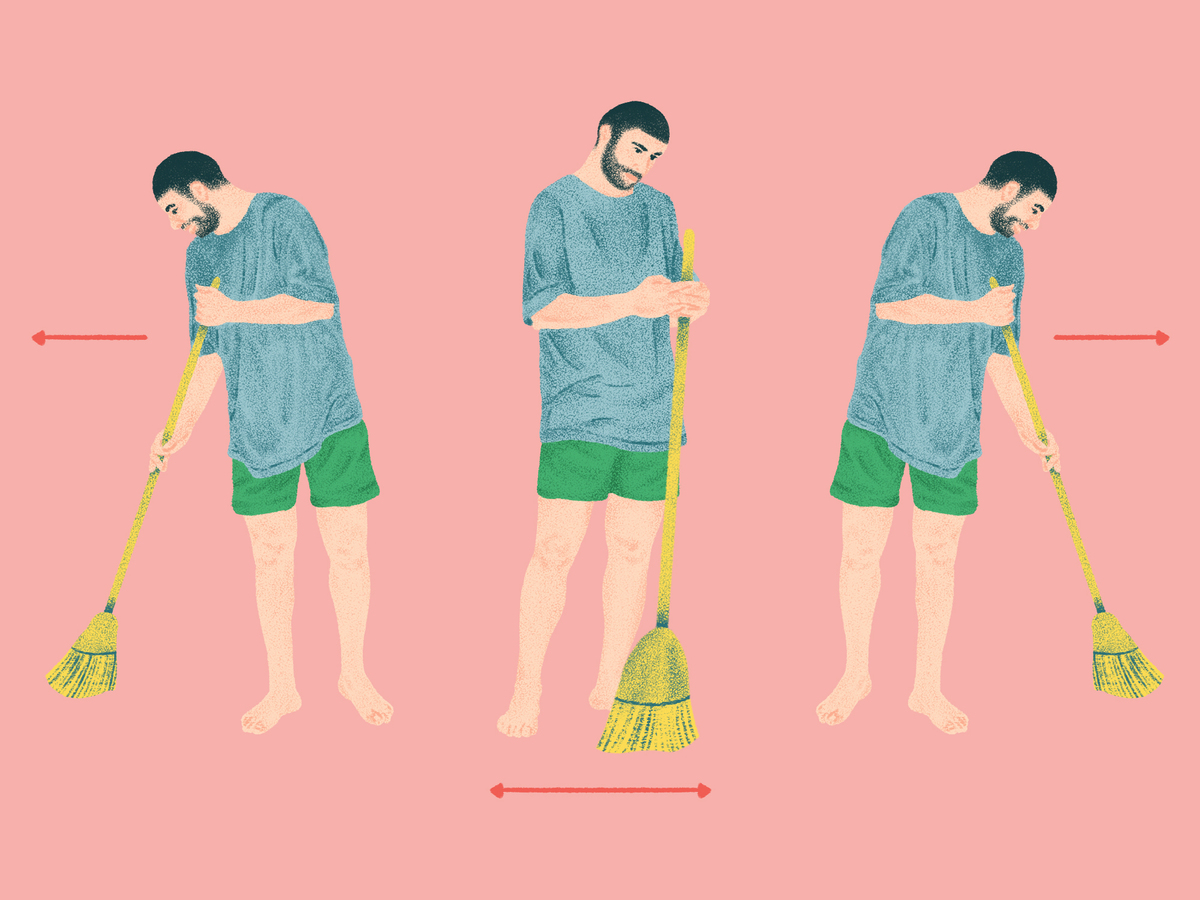
Add five minutes of fun and easy exercise to your day at home by working with your surroundings, says trainer Molly MacDonald.
Cha Pornea for NPR
Hide caption
Toggle caption
Cha Pornea for NPR

Add five minutes of fun and easy exercise to your day at home by working with your surroundings, says trainer Molly MacDonald.
Cha Pornea for NPR
Of all the ways in which the pandemic has impacted Americans’ wellbeing, perhaps the least we have noticed is how much we sit. And it’s not just bad for our waistlines – it’s bad for our mental health.
More than a year and a half of social distancing and working from home guidelines have resulted in less time moving and more time sitting and looking at screens – a potentially toxic combination that has been linked to poorer mental health .
“The devious effects of the pandemic that we may not even notice [is] that we’ve changed the way we sit, “says Jacob Meyer, director of the Wellbeing and Exercise Lab at Iowa State University.
His own research showed that during the first few weeks of the pandemic, people who did less exercise and had more screen time were likely to be stressed, depressed, and lonely.
And while most people saw their mental health gradually improve as they adjusted to a new reality, people who remained heavily sedentary did not loudly see the same improvement a follow-up study by Meyer. “People who continued to sit a lot did not improve their depression,” says Meyer.
The good news is that something as simple as very slight movement around the house to break up all of the couch surfing time can make a difference in your mood, there Meyer’s earlier research has found.
Numerous previous studies confirm that physical activity increases mood, relieves anxiety, and improves sleep quality.
“We know consistently that the more people are active, the more they move, the better their mental state,” says Meyer.
For many office workers like me, working from home means getting into the routine of sitting at a desk for hours. With another pandemic winter ahead and much of the country and world still dealing with COVID and often stuck at home more than we’d like, it’s time to sit less and exercise more.
Meyer and other exercise experts have provided some tips to get you started:
Think small
If you haven’t exercised during the pandemic and are too intimidated to start now, don’t worry, Meyer says. Start small.
“If I was walking around my office, all of these steps would count, it would be helpful,” he says.
Often times, people trying to start exercising fall into an “all-or-nothing” mindset, says Ohio State University sports psychologist Jennifer Carter.
“It’s like I’m either doing zero or two hours and if I don’t get two hours it doesn’t count or it’s not good enough,” she says. But the reality is that “five minutes is better than none”.
In fact, “going from no activity at all to a little activity is going to have some of the biggest health effects,” Meyer says compared to someone who already works out regularly.
Make it easier for you
“I think part of developing a good workout plan for each of us is knowing ourselves well and what can be done,” says Carter. And that includes knowing what is not realistic for you.
If you hate running, then just because it’s trendy or someone says it’s good for you, don’t run, says Carter. Or if you’re not a morning person, don’t plan on exercising in the morning.
And remember, she adds, “Getting started is the hardest part.” If you’re having trouble getting started, don’t blame yourself. It is important to have compassion for yourself. “One of the tenets of self-compassion is this shared humanity that we all struggle against,” she says.
Try to find ways that will make it more likely that you will stick to the training plan, perhaps by incorporating external accountability. She suggests calling or texting a friend at an agreed time to encourage each other to go for a walk or run. Carter did it with her friend in the morning, she says, and “that would get us going and take on that responsibility.”
Go whenever you can
Start by just walking more, says Molly McDonald, a certified personal trainer at Corporate Fitness Works who I also train with.
“I’ve told a lot of people that if you have space … in your house, go from room to room, use your stairs,” she says. “And if you don’t have stairs, just go back and forth from room to room to get those extra steps.”
Meyer agrees that less sitting and more walking will make a big difference. “If you have virtual meetings, use the beginning and the end of that meeting as an opportunity to walk the block or take out the trash, or maybe there is a place somewhere nearby that you would like to go,” he says. “You could go there and go back just to get the same habit of changing your sitting habits.”
Another approach that many people are now using is the “virtual commute,” he adds, “where they walk around their home or neighborhood at the start of the day to commute to work.” And at the end of the day you can walk again.

Find ways to get up, get your blood pumping, or increase activity by using your muscles. Start with squats, suggests fitness trainer Molly MacDonald.
Cha Pornea for NPR
Hide caption
Toggle caption
Cha Pornea for NPR

Find ways to get up, get your blood pumping, or increase activity by using your muscles. Start with squats, suggests fitness trainer Molly MacDonald.
Cha Pornea for NPR
5-minute workouts add up
If you’re having a hard time blocking part of your day off for walks or other exercise, try spending just a few minutes exercising every hour, suggests McDonald.
“If you have five minutes every hour, that adds up over the day,” she says.
Just add it to your calendar and set a timer for 5 minutes, she adds. For an eight-hour day, that’s 40 minutes a day.
“That’s 40 minutes of doing something, and it wasn’t a 40-minute piece to get out of your day,” she says. Health guidelines recommend at least 150 minutes moderate exercise every week. And these 40 minute daily activities will help meet the weekly goal, she adds.
Increase the intensity in short doses
Light exercise around the house is a good start, but “Every minute of higher-intensity activity is associated with better health outcomes than every minute of lower-intensity activity,” says Meyer. “So if you have five minutes, the more you can do in those five minutes, the better.”
If you want to do more intense short workouts, start with squats, lunges, pushups, and planks, says McDonald.
“A lot of bodyweight exercises are really well distributed throughout the day, [and] help with the circulation. “
If you’ve never done these exercises before, she suggests starting with squats.
“This is a great place for anyone to start,” she says. “Just lean your back against the wall, bend your knees, and see how comfortable you are.”
How many squats or lunges we should aim for, she says, “There’s no such thing as a magic number.” Just fit as many as you can into the time you have. “Maybe you really only have two minutes. Well, do what you can in two minutes.”
You can try adding some weight to your mini workouts by using items around your house like a can of beans or a sack of sugar, says McDonald. But be careful not to grip too heavily until you get a feel for your own strength.
If more intense exertion feels daunting, remember that “exercise, even at low intensity, can have the same mental health effects as doing things at higher intensity,” says Meyer. Especially if you are depressed and / or don’t walk around a lot at first. “Doing anything in those five minutes is better than doing nothing.”

Do you sweat while sweeping? McDonald also advises its customers to do some tasks during these breaks – anything that involves standing or walking.
Cha Pornea for NPR
Hide caption
Toggle caption
Cha Pornea for NPR

Do you sweat while sweeping? McDonald also advises its customers to do some tasks during these breaks – anything that involves standing or walking.
Cha Pornea for NPR
Do tasks that move you
McDonald also advises its customers to do some tasks during these breaks – anything that involves standing or walking. “I’m taking the chance now to just walk down the hall to pick up the trash [out]”Just so I can get up from my seat,” she says.
Personally, I’ve turned to my two favorite things to do – emptying the dishwasher and doing the dishes. And Mcdonald says this is a good move.
“You stand there and wash your dishes [and it] will improve your blood circulation because you are no longer sitting, “says McDonald.” You are using your legs, your muscles, [and] your muscles demand the blood flow to start again. “
multitasking
You can also do these exercises during phone calls or zoom meetings, says McDonald, as long as you don’t have to be in front of the camera. This has been something I’ve been trying for months – I’m trying to make sure I’m either doing a quick exercise, or at least moving or doing tasks at meetings that don’t require me to be in front of the camera.
And if that’s what you’re going to do, just make sure to mute yourself, McDonald adds. You probably don’t want your coworkers to hear you puff and puff during your workout. “Some people have learned [that] the hard way, ”she says.
Thank You For Reading!
Reference: www.npr.org
